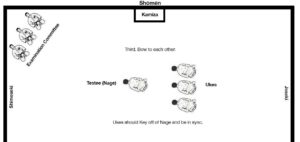Weapons practice is an integral part of Aikido.
Jim Hyde, 2nd Dan.
Weapons practice is an integral part of Aikido – most of the movements we make in class have parallels to weapons (bokken and jo) techniques and practicing the kata improves alignment, coordination, and movement.
Our testing requirements at Aikido of Charlotte include 4 weapons kata, 2 jo and 2 bokken, which serve as the foundation for the weapons work that we do. Just as ukemi warm-ups and tai sabaki are excellent before class, it’d extremely beneficial to run through these kata at every chance.
One of the temptations of going to seminars is being exposed to new kata that are different and exciting and then focusing your practice only on those. It’s great to expand one’s repertoire, but you also need to remember the foundational kata of our dojo and work to improve those first and foremost. The standard kata should be second nature before more advanced kata are delved into too deeply.
Ed Haponik, 2nd Dan.
One thing which can be tough to reconcile is why an art like aikido includes weapons at all, when so much of it is about creating harmony and resolving conflict. Of course, our weapons work is not specifically for self-defense (not a lot of people walking around with katanas these days). Instead, it is about establishing the mindset of the samurai.
Our weapons work helps us to practice and maintain “zanshin” – the presence of mind which would have been necessary for survival during Japan’s feudal era. The kata and exercises we practice force us to get out of our own heads and exist in the moment. This practice becomes its own form of meditation and greatly enhances not only our aikido practice, but our attitude toward daily life as well. It’s funny, but getting your bokken in position to block an incoming strike has a way of putting our mundane day-to-day problems in perspective.
Not everyone understands this integration of traditional weapons practice or how it applies to our modern world. And certainly, the learning curve can be challenging. However, I find it to be the component above all others which has kept me motivated in aikido year after year, and I think the mindset it cultivates (if not the techniques themselves) is absolutely relevant to becoming an effective martial artist and a well-rounded person.
For more Blog posts like “Randori versus Jiyu Waza” check back regularly.
5 Questions with our Chief Instructor – Part 2
5 Questions with our Chief Instructor – Part 2 Jared Heintz: Aikido is often praised for its applicability in self-defense situations. Could you discuss how Aikido techniques can be adapted to real-world scenarios, and what mindset one should cultivate in such situations? Weiner Sensei: As I approach 25 years of Aikido practice, I’ve realized that…
Rank Testing Bowing Reiho – Advanced
Rank Testing Bowing Reiho – Advanced Andy Demko Shihan likes to say, “The little things don’t mean a lot, they mean everything”. Everyone who has practiced in our dojo or visited has seen that we take Reiho (Etiquette) pretty seriously. In all that we do, practice. Bowing. Addressing each other & more. I learned a…
Sensei
Sensei 先生 The two characters that make up the term can be directly translated as “born before,” and imply one who teaches based on wisdom gained from age and experience. In general usage, it is used, with proper form, after a person’s name and means “teacher.” In Japan, the word is also used as a…



